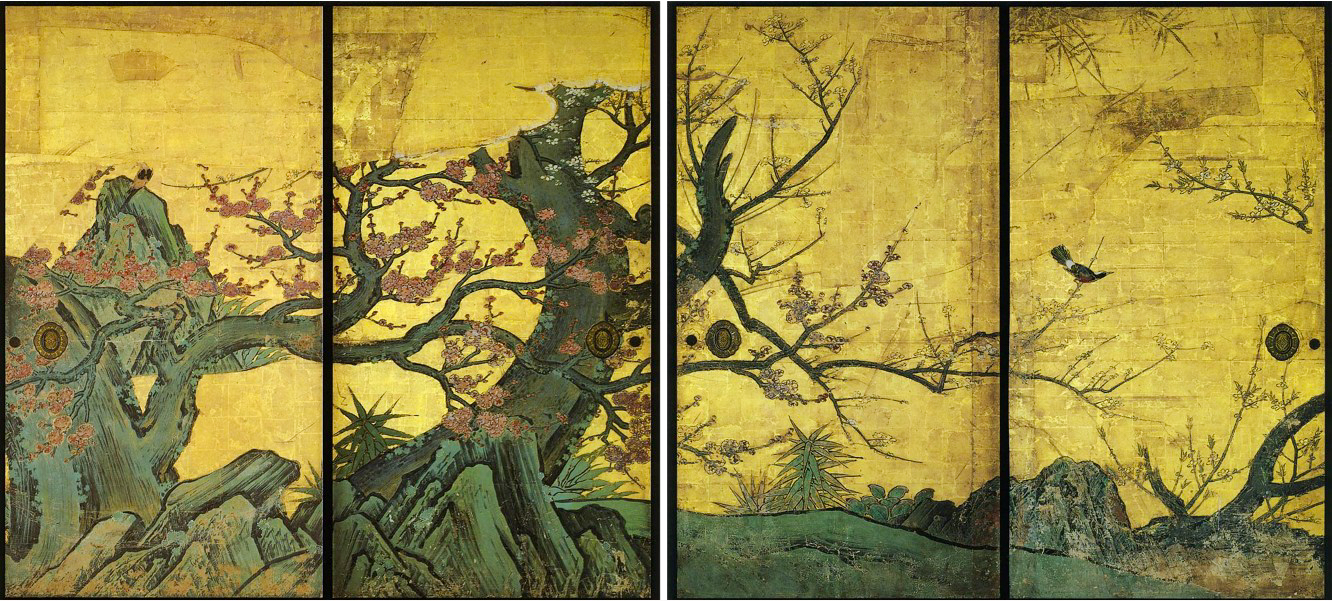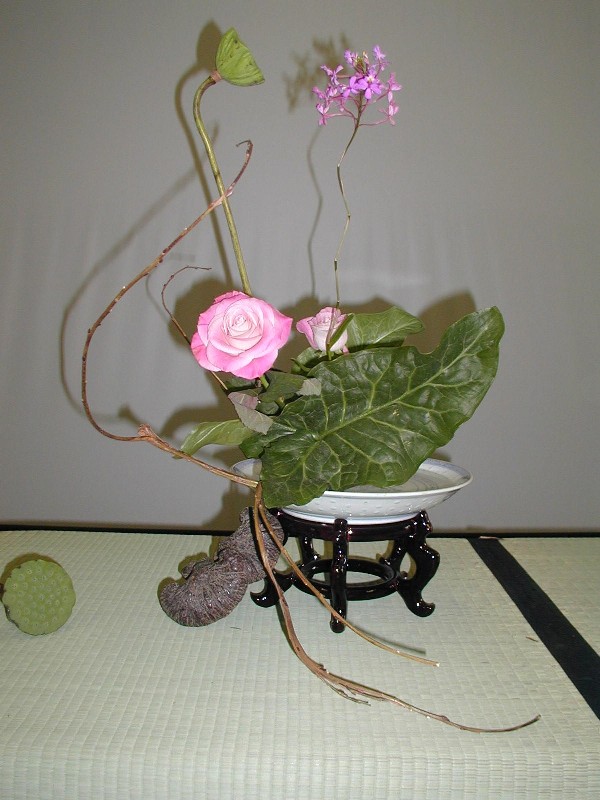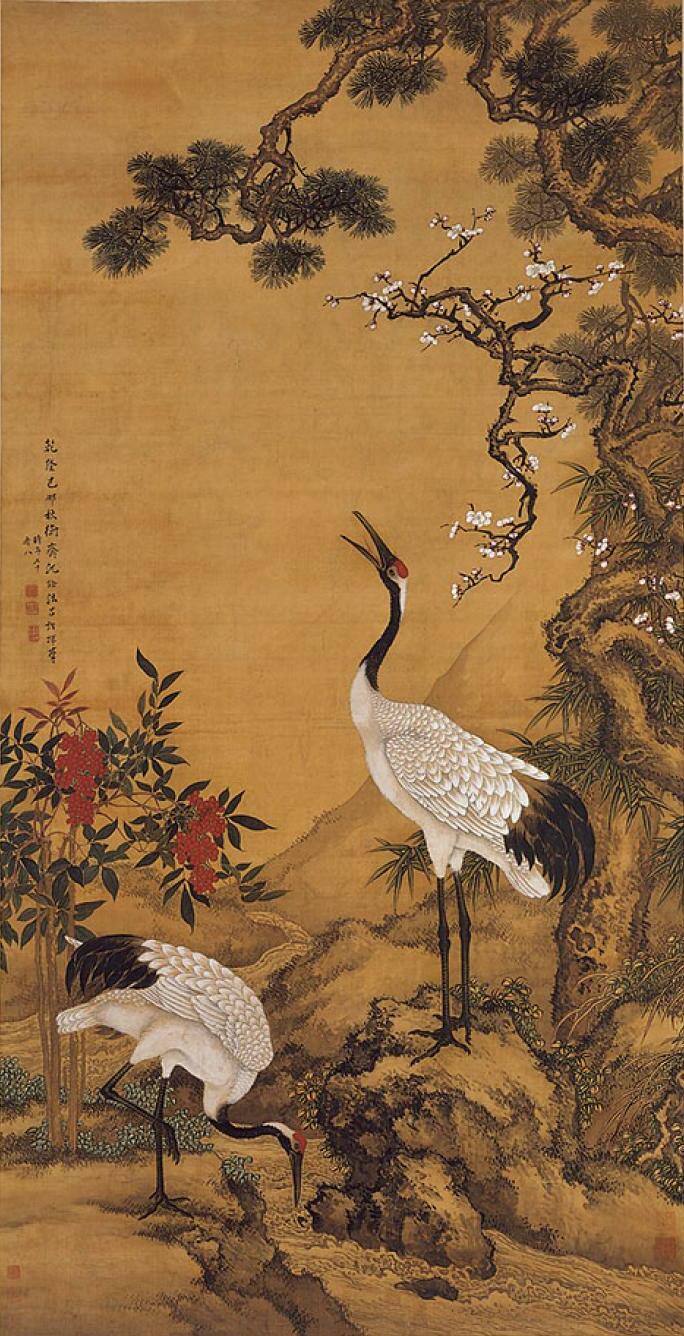|
Bunjinga
, also known as , was a school of Japanese painting which flourished in the late Edo period among artists who considered themselves literati, or intellectuals. While each of these artists was, almost by definition, unique and independent, they all shared an admiration for traditional Chinese culture. Their paintings, usually in monochrome black ink, sometimes with light color, and nearly always depicting Chinese landscapes or similar subjects, were patterned after Chinese literati painting, called ''wenrenhua'' () in Chinese. Etymology The name ''nanga'' is an abbreviation of ''nanshūga'', referring to the Southern School () of Chinese painting, which is also called " literati painting" (). History Chinese literati painting focused on expressing the rhythm of nature, rather than the technical realistic depiction of it. At the same time, however, the artist was encouraged to display a cold lack of affection for the painting, as if he, as an intellectual, was above caring d ... [...More Info...] [...Related Items...] OR: [Wikipedia] [Google] [Baidu] |
Tomioka Tessai
was the pseudonym for a painter and calligrapher in imperial Japan. He is regarded as the last major artist in the ''Bunjinga'' tradition and one of the first major artists of the ''Nihonga'' style. His real name was Yusuke, which he later changed to Hyakuren. Biography Tessai was born in either 1836 or 1837 in Kyoto, as the second son of Tomioka Korenobu, who sold sacerdotal robes. Because his hearing was not good his parents decided he should be a scholar, rather than a merchant. He was educated as a scholar in classical Chinese philosophy and literature and the ancient Japanese classics under noted ''kokugaku'' scholar Okuni Tadamasa. Tessai's father died in 1843, when he was only seven. The family fortunes declined, and young Tessai became a page at a Shinto shrine. Twelve years later, he came to be lodged with the now-famous Buddhist poet and nun Ōtagaki Rengetsu, who would become his greatest scholarly mentor and supporter. He developed his own style over the next decade ... [...More Info...] [...Related Items...] OR: [Wikipedia] [Google] [Baidu] |
Senchadō
is a Japanese variant of ''chadō'' ("way of tea"). It involves the preparation and drinking of ''sencha'' green tea, especially the high grade ''gyokuro'' type. History Towards the end of the 17th century in the Edo period, Chinese merchants visiting Nagasaki showed how brewed tea should be drunk, as practised in the Ming dynasty court. This practise of the Chinese tea culture spread in the 18th century until the beginning of the Meiji era, particularly among literati merchants, in the form of friends meeting in a less formal atmosphere than the ''chanoyu''. Appreciation of painting and literacy objects then took on particular importance. These meetings, often followed by genuine meals, were the opportunity to admire the host's collections, most often composed of objects imported from China or made in Japan in Chinese style called ''karamono''. In difference to the preparation of ''matcha'' tea, which is powdered, ''sencha'' is prepared using small leaf tea. Similarly to ... [...More Info...] [...Related Items...] OR: [Wikipedia] [Google] [Baidu] |
Literati Painting
Ink wash painting ( zh, t=水墨畫, s=水墨画, p=shuǐmòhuà; ja, 水墨画, translit=suiboku-ga or ja, 墨絵, translit=sumi-e; ko, 수묵화, translit=sumukhwa) is a type of Chinese ink brush painting which uses black ink, such as that used in Asian calligraphy, in different concentrations. It emerged during the Tang dynasty of China (618–907); it overturned earlier, more realistic techniques. It is typically monochrome, using only shades of black, with a great emphasis on virtuoso brushwork and conveying the perceived "spirit" or "essence" of a subject over direct imitation. Ink wash painting flourished from the Song dynasty in China (960–1279) onwards, as well as in Japan after it was introduced by Zen Buddhist monks in the 14th century. Some Western scholars divide Chinese painting (including ink wash painting) into three periods: times of representation, times of expression, and historical Oriental art. Chinese scholars have their own views which may be differ ... [...More Info...] [...Related Items...] OR: [Wikipedia] [Google] [Baidu] |
Japanese Painting
is one of the oldest and most highly refined of the Japanese visual arts, encompassing a wide variety of genres and styles. As with the history of Japanese arts in general, the long history of Japanese painting exhibits synthesis and competition between native Japanese aesthetics and the adaptation of imported ideas, mainly from Chinese painting, which was especially influential at a number of points; significant Western influence only comes from the 19th century onwards, beginning at the same time as Japanese art was influencing that of the West. Areas of subject matter where Chinese influence has been repeatedly significant include Buddhist religious painting, ink-wash painting of landscapes in the Chinese literati painting tradition, calligraphy of sinograms, and the painting of animals and plants, especially birds and flowers. However, distinctively Japanese traditions have developed in all these fields. The subject matter that is widely regarded as most characteristic o ... [...More Info...] [...Related Items...] OR: [Wikipedia] [Google] [Baidu] |
Tani Bunchō
was a Japanese literati (''bunjin'') painter and poet. Biography He was the son of the poet Tani Rokkoku (1729–1809). As his family were retainers of the Tayasu Family of descendants of the eighth Tokugawa ''shōgun'', Bunchō inherited samurai status and received a stipend to meet the responsibilities this entailed. In his youth he began studying the painting techniques of the Kanō school under Katō Bunrei (1706–82). After Bunrei's death, Bunchō worked with masters of other schools, such as the literati painter Kitayama Kangen (1767–1801), and developed a wide stylistic range that included many Chinese, Japanese and European idioms. He rose to particular prominence as the retainer of Matsudaira Sadanobu (1759–1829), genetic son of the Tayasu who was adopted into the Matsudaira family before becoming chief senior councilor (''rōjū shuza''; 老中首座) of the Tokugawa Shogunate in 1787. Bunchō is best known for his idealized landscapes in the literati style ... [...More Info...] [...Related Items...] OR: [Wikipedia] [Google] [Baidu] |
Bunjinbana
is a style of ikebana that is inspired by traditional Chinese landscapes. It developed from the '' Bunjinga'' (文人画 "literati painting") movement among different Japanese artists of the late Edo period, who however all shared an admiration for traditional Chinese culture and paintings. The style is also known as ''bunjinka''. ''Morimono'' (盛り物) is counted as a sub-form of ''bunjinbana'' by some school. See also * ''Moribana ''Moribana'' (盛り花, 盛花) is one of the expressions of Japanese flower arrangement ''Ikebana''. The word ''Moribana'' means "full bloom flowers". History This style was introduced by Unshin Ohara around 1890 after the Meiji Restoratio ...'' * '' Senchadō'' References External links Ikebana {{Japan-culture-stub ... [...More Info...] [...Related Items...] OR: [Wikipedia] [Google] [Baidu] |
Bonsai
Bonsai ( ja, 盆栽, , tray planting, ) is the Japanese art of growing and training miniature trees in pots, developed from the traditional Chinese art form of ''penjing''. Unlike ''penjing'', which utilizes traditional techniques to produce entirely natural scenery in small pots that mimic the grandiose shapes of real life scenery, the Japanese "bonsai" only attempts to produce small trees that mimic the shape of real life trees. Similar versions of the art exist in other cultures, including the miniature living landscapes of Vietnamese . It was during the Tang dynasty, when ''penjing'' was at its height, that the art was first introduced in Japan. The loanword "bonsai" (a Japanese pronunciation of the Chinese term ''penzai'') has become an Hyponymy and hypernymy, umbrella term in English, attached to many forms of diminutive potted plants, and also on occasion to other living and non-living things. According to Stephen Orr in ''The New York Times'', "the term should be rese ... [...More Info...] [...Related Items...] OR: [Wikipedia] [Google] [Baidu] |
Nanpin School
The Nanpin school (南蘋派 ''Nanpin-ha'') was a school of painting which flourished in Nagasaki during the Edo period. Etymology The school takes its name from Nanpin, the art name of Chinese painter Shen Quan (1682–1760), an artist who painted in the Ming academic style. History Shen Quan arrived in Nagasaki on the 37th ship on December 3, 1731, and left Japan two years later, on September 18, 1733. He specialised in bird-and-flower painting (Ch: ''huaniao hua'', J: ''kachōga''), one of the major artistic subjects, especially among professional Chinese painters. The commercial activity in the port of Nagasaki facilitated the spread of Western knowledge in Japan. Japanese people were also particularly interested in ancient Chinese culture. Paintings of the Nanpin school show flora and fauna that are not just "realistic", but styled as they appear in Chinese and European treatises. In the 18th century, Japanese people became very interested in Western natural sciences ... [...More Info...] [...Related Items...] OR: [Wikipedia] [Google] [Baidu] |
Watanabe Kazan
was a Japanese Painting, painter, scholar and statesman member of the samurai class. Biography He was born Watanabe Sadayasu in Edo (now Tokyo) to a poor samurai family, and his artistic talent was developed from an early age. His family served the Daimyō, lord of the Tahara Domain, located in present-day Aichi prefecture. Watanabe himself served the lord of Tahara as a Karō, senior councilor, one of his achievements being said to be protecting the domain from even a single death from starvation during the Tenpō famine. He was heavily influenced by the artistic styles of Western world, the West, forming a unique style with elements of Japanese and European art. Like many other Edo-period artists, Kazan painted realistic portraits of his subjects using the effects of shading which he learned from European paintings. On the one hand, he was a traditionalist Confucian, who believed in filial piety and loyalty to his ''daimyō'', and on the other he was enthusiastic about We ... [...More Info...] [...Related Items...] OR: [Wikipedia] [Google] [Baidu] |
Yamamoto Baiitsu
Yamamoto Baiitsu (山本梅逸) (1783–1856) was a Japanese Edo period painter. Biography He was born in Nagoya, son of the sculptor Yamamoto Yumigiemon. His father was in the service of the court of the Tokugawa lords of the Owari Domain. He was close friends with the painter Nakabayashi Chikuto (1776-1853). Works Two of his paintings have been designated as important cultural property. His works are held in several museums, including the Metropolitan Museum of Art, the Tokyo Fuji Art Museum, the Minneapolis Institute of Art, the Art Gallery of New South Wales, the Art Gallery of South Australia, the Art Gallery of Greater Victoria, the Denver Art Museum, the Santa Barbara Museum of Art, the Museum of Fine Arts, Boston, the University of Michigan Museum of Art, the Philadelphia Museum of Art, the British Museum, the Portland Art Museum, the Asian Art Museum in San Francisco, the Honolulu Museum of Art, the Walters Art Museum, the Harvard Art Museums, the Fralin Museum o ... [...More Info...] [...Related Items...] OR: [Wikipedia] [Google] [Baidu] |
Nakabayashi Chikutō
Nakabayashi Chikutō, originally Nariaki (Japanese:中林 竹洞; (1776, Nagoya - 27 April 1853, Kyoto) was a Japanese painter in the nanga style. His other art names include Chūtan (沖澹), Taigen’an (太原庵) and Tōzan Inshi (東山隠士). Life and work He was the son of a doctor and displayed an interest in art at a very early age. At the age of fourteen, he and his friend, Yamamoto Baiitsu (who was only seven) made the acquaintance of Kamiya Ten’yū (?-1803), a wealthy merchant who collected art and calligraphy and helped them pursue their artistic education. His first works were copies made from Kamiya's collection. He was especially influenced by ink drawings from the period of the Chinese Yuan Dynasty and the painting techniques of Ni Zan. At the age of twenty, he opened his own studio in a small temple. After Kamiya's death, he and Baiitsu went to Kyoto to pursue an interest in classical literature and became members of the literary circle focused on the phil ... [...More Info...] [...Related Items...] OR: [Wikipedia] [Google] [Baidu] |
Kameda Bōsai
was a Japanese literati painter ('' nanga'' in Japanese). He originally trained as a Confucian scholar, but spent the second half of his life as a literati and artist. The book ''Mountains of the Heart'' contains many of his most famous paintings. References * Addiss, Stephen, Kameda Bôsai’s Mountains of the Heart, ''Daruma Magazine ''Daruma Magazine'' was a quarterly English language magazine published in Amagasaki, Japan and devoted to Japanese art and antiques. It was published by Takeguchi Momoko and edited by author Alistair Seton. It commenced publication in 1993. In ...'', No. 60, 48-52, 2008. * Addiss, Stephen, ''The world of Kameda Bôsai, the calligraphy, poetry, painting, and artistic circle of a Japanese literatus'', New Orleans, New Orleans Museum of Art, 1984. * Bôsai, Kameda ''Mountains of the Heart'', New York, G. Braziller, 2007. External linksBridge of dreams: the Mary Griggs Burke collection of Japanese art a catalog from The Metropolitan Museum of ... [...More Info...] [...Related Items...] OR: [Wikipedia] [Google] [Baidu] |






